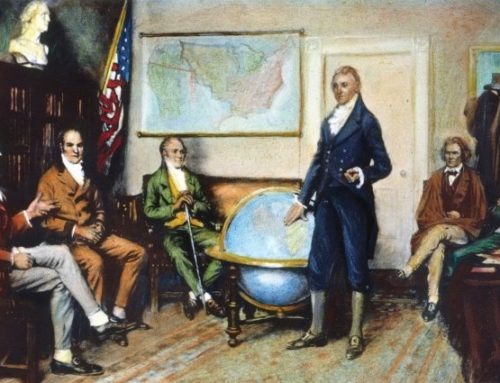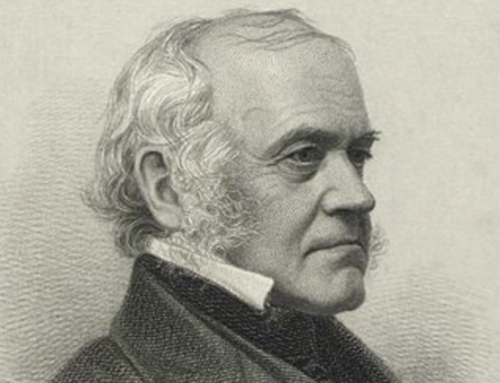Expertly researched and well written, “Manufacturing Militarism” considers the history of propaganda over the last 100 years of American history, focusing especially on the Iraq War and the continuing War on Terrorism.
Manufacturing Militarism: U.S. Government Propaganda in the War on Terror by Christopher J. Coyne and Abigail R. Hall (Stanford University Press, 2021)
Given the COVID lockdown of 2020 and a year-long sabbatical (2020-2021), I’ve had the chance to read more books in a sixteen-month period than I’ve ever in any other period of my adult life. Not surprisingly, most of the books I’ve read were pretty good, a very small few were merely ok, and others were simply outstanding.
One of the best, by far, was Manufacturing Militarism: U.S. Government Propaganda in the War on Terror, by Christopher J. Coyne and Abigail R. Hall.
Before getting into my review, I’ll admit my bias. I’ve known Professor Hall for nearly a decade now, and I think she is one of the single finest young scholars I’ve ever met. Integrity and tenacity define everything she does, in and out of the classroom and in and out of her scholarship. Manufacturing Militarism not only reflects the best of the best I’ve read this past year, but it also reflects the best of the best of what Professor Hall does.
To the review. . . .
Expertly researched and well written, Manufacturing Militarism considers the history of propaganda over the last 100 years of American history, focusing especially on the Iraq War and the continuing War on Terrorism. Though, Professors Coyne and Hall stress, the United States has never been entirely free of propaganda—the deliberate stress of certain information at the expense of other information with the intent of persuading a majority of a population of a governmental policy or direction—propaganda has been, more or less, systematic since 1917.
During World War I, President Woodrow Wilson issued executive order 2594, establishing the Committee on Public Information. A mere twenty-five years later, President Franklin Roosevelt issued executive order 9182, creating the Office of War Information. A mere six years later, in 1948, Congress passed the massive Smith-Mundt Act, establishing the Voice of America as a permanent fixture of United States foreign policy. Five years after that, in 1953, President Eisenhower established the United States Information Agency, attempting to unify the American government’s PR, at home and abroad. At roughly the same time, the CIA created Operation Mockingbird, an attempt to influence domestic and foreign journalists to accept the American government’s perspective on world events. In addition, the Department of Defense has spent billions on PR. Such expenditures and outreach have only increased over the years, and, as the authors note, especially since the Iraq War of 2003. Though only some information is available to track such things, the U.S. government spent a massive $4.3 billion on PR just between 2007 and 2014. “Based on the number of employees,” Professors Coyne and Hall write, “the U.S. government is the second largest PR firm on the globe.” Add this to the cost of the “War on Terror”—roughly $6.4 trillion from its beginning through 2020—and the expense is simply staggering and beyond mind boggling.
Though I just attempted to define propaganda in the previous paragraph, it is important to note that Professors Coyne and Hall offer four attributes of/for American propaganda. First, it appeals to authority. Second, it appeals to patriotism. Third, it defines things and situations and persons in a Manichean fashion, stressing “us vs. them.” Finally, fourth, as with all propaganda, American propaganda appeals to that which is simple, especially in its images and slogans. As the authors wisely note, it is nearly impossible for a society to remain free, open, and constitutional if the government is using the very resources of the people to persuade the people of its righteousness in such a selective way. Still, as the authors caution, propaganda is not force, and it can only work on a population that allows it—through its history, its habits, and its customs—to work. “Propagandists must act to either persuade recipients within the acceptable range of actions or persuade them to shift their frame of what they deem acceptable,” the authors note. “In either case, the recipient’s frame serves as a constraint on the influence of the propaganda.” And, the authors write, there are always those who actively defend the use of propaganda as a part of government policy as a worthy “noble deception,” that is, the use of resources and information for the common good of/for those who do not know better.
The first (almost) half of the book offers an analysis of propaganda as well as the history of the Iraq War and the fascinating—if disturbing—attempt by the U.S. Government, especially through the efforts of the executive branch—to control the flow of information to the American people. To be sure, President George W. Bush does not come off too well in this retelling of history. Rather, it seems very clear, that far from the squeaky clean, All-American image he often presented himself as, President Bush was incredibly manipulative and duplicitous. If not Bush, his underlings, though, of course, he was ultimate responsible for them.
The second (slightly more than) half of the book looks at the myriad of ways in which the government uses its influences in various parts—some private, some not—of society. Some surprised me (such as with professional sporting events), while others merely angered me (the TSA).
In the chapter, “Paid Patriotism,” the authors point out that many of the times in which the military (or a specific serviceman or woman) is honored—in the NHL and NFL—are times in which the military has actually paid the team, as an advertisement, to do such things. “The DOD paid at least $6 million to NFL teams for such activities between 2012 and 2015,” Professors Coyne and Hall argue. “All the while, taxpayers, game attendees, and viewers were completely unaware that these patriotic displays were bought and paid for by the U.S. government as a form of propaganda.” In other words, the idea is to make the tributes to the military look spontaneous and patriotic, whereas, in reality, they are cynical commercial ploys. Sports are not only important as a way of bringing Americans together (the vast majority of Americans love sports, especially football), but they also serve as a metaphor for American military adventures abroad, especially in the “us and them” use of propaganda. Further, the authors contend, it is relatively easy to conflate war and sports. “War is transformed,” they write, convincingly,” into the sort of entertainment Americans consume on a regular basis.”
TIC has, of course, been an opponent of the Transportation Security Administration from our inception. In their chapter, “Flying the Propagandized Skies,” Professors Coyne and Hall make clear that the TSA has not only done nothing demonstrable to prevent further terrorist acts against the United States, but, by creating a form of nonsensical “security theater,” has actually weakened the population as a whole in its proper just defense of American soil. Despite this, the agency requested a budget of nearly $8 billion during the 2020 fiscal year. Additionally, with almost no oversight, the TSA has been collecting photos (nude, due to the machines in use throughout the country) of Americans for years now, storing at least some of them for “training purposes.”
Finally, the authors write a gloriously disturbing chapter on the use of DOD, NSA, and CIA funding in Hollywood movies. These three agencies have immense control over Hollywood pocketbooks and frequently shape scripts to make the members of those agencies look more heroic and less cynical. Such an alliance between Hollywood and the U.S. government dates back to the first World War, when Woodrow Wilson first supported film as a means by which to convince the many of a truth (so called).
As already noted, Manufacturing Militarism is an extraordinary book—the kind which deserves the support (and ownership) of every reader of TIC. Manufacturing Militarism is, at once, both intelligent and frightening. As I read it, I felt as though I was listening to Cicero decry the end of the republic. Let’s hope we’re not as close to all that as it seems. But, I remain worried that we are.
The Imaginative Conservative applies the principle of appreciation to the discussion of culture and politics—we approach dialogue with magnanimity rather than with mere civility. Will you help us remain a refreshing oasis in the increasingly contentious arena of modern discourse? Please consider donating now.
The featured image is courtesy of Pixabay.








For a more complicated picture, consider the case of Ana Montes, a sixteen-year careerist mole within the Defense Intelligence Agency (DIA) and who, during this long period, had been sending Castro some of America’s most closely guarded secrets. She was finally arrested in September 2001, less than twenty-four hours before learning details of the U.S. plan to invade Afghanistan post-September 11. She was found out by an internal secret investigator within the DIA (Scott Carmichael, “True Believer,” Naval Institute Press, 2007).